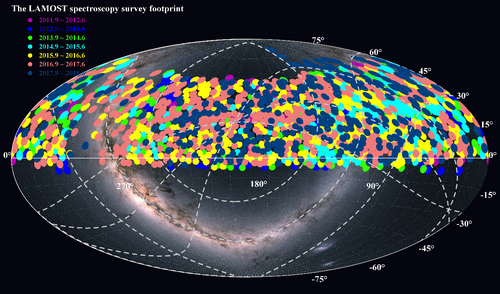On September 30, 2020, according to the international astronomical practice and the LAMOST Spectral Survey Data Policy, LAMOST published its sixth Data Release (DR6 v2) to astronomers worldwide, which includes all the spectra obtained during the pilot survey through the sixth-year regular survey.
After the first phase of LAMOST regular low-resolution spectroscopic survey, the medium-resolution commissioning was launched in the sixth-year regular survey. In the medium-resolution spectroscopic survey, LAMOST performed the medium- and low-resolution survey alternatively. Therefore, the released DR6 dataset includes both the regular low- and medium-resolution spectral data.
Obtained from the observation of 4,901 plates, a total of 11.27 million spectra are released internationally in the DR6, including 9.91 million low-resolution spectra, 0.5 million medium-resolution non time-domain spectra and 0.86 million medium-resolution time-domain spectra. The number of high-quality (S/N >10) spectra reaches to 9.38 million. Moreover, a stellar spectral parameter catalogue of 6.13 million stars is also released worldwide in DR6, in which the abundances of 12 elements, e.g., carbon, magnesium, calcium, and so on, are included for part of the stars for the first time.
Up to now, more than 11 million spectra have been released by LAMOST, covering a sky area of more than 20 thousand square degrees. By establishing the world’s largest and invaluable astronomical database, LAMOST has brought the field of Galactic formation and evolution into a whole new era.
Information of DR6 v2 dataset in detail:

The National Astronomical Data Center has built a downloading platform in order to share the astronomical data. Scientific users worldwide can log on the website at http://dr6.lamost.org for data query and download.
The LAMOST DR6 was firstly released to domestic astronomers and international collaborators in March of 2019. The data has been released to the international community in September of 2020.
LAMOST data have triggered various researches which have already led to a number of exciting and significant discoveries. Based on the new dataset, astronomers will continue to refresh our understanding of the universe.

Figure: Footprint of the LAMOST pilot survey and the six years' regular survey. (Credit: LAMOST)

Address: 20A Datun Road, Chaoyang District, Beijing, China code: 100012
Tel: 010-64888708 E-mail: naoc@nao.cas.cn

